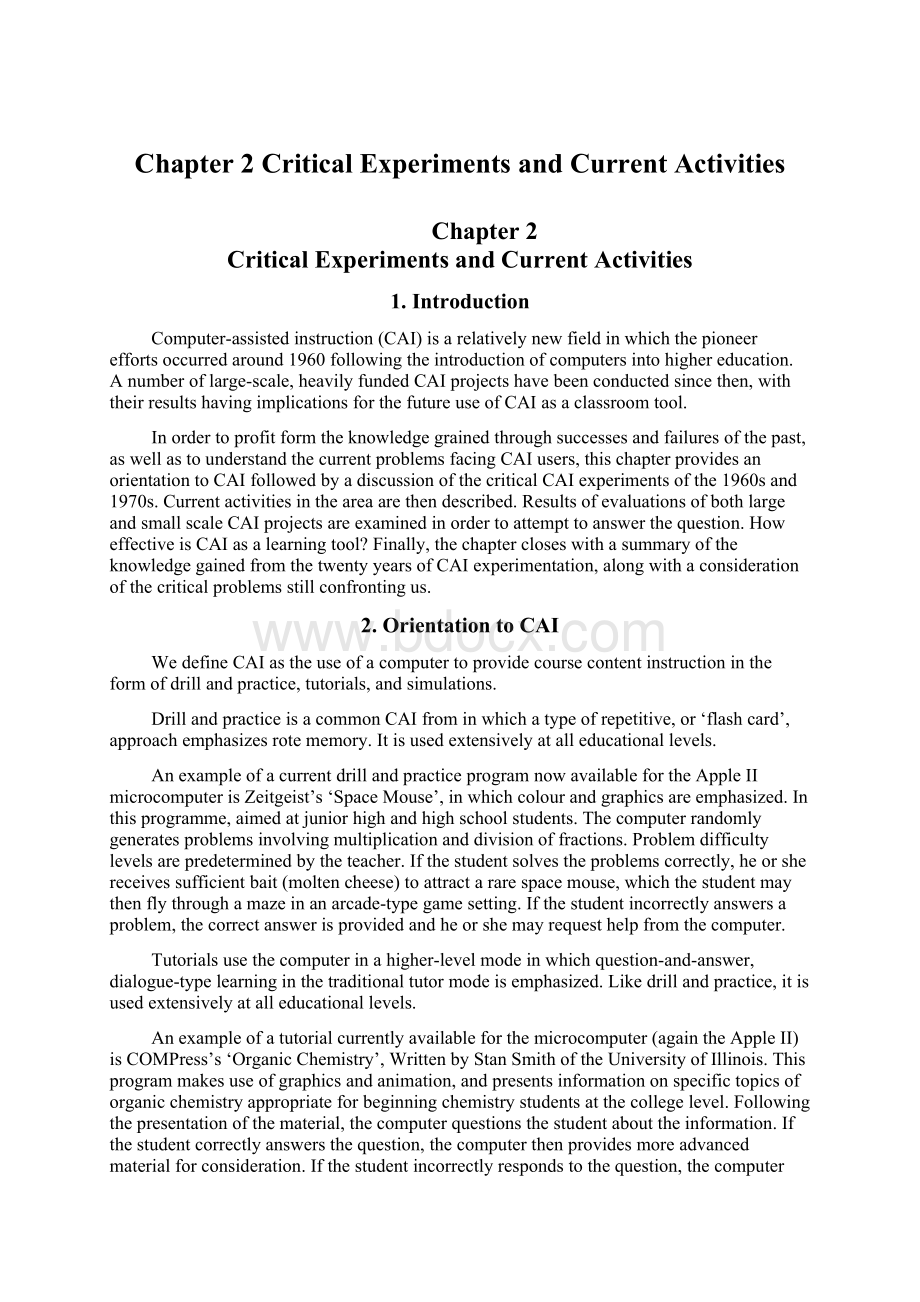Chapter 2 Critical Experiments and Current Activities文档格式.docx
《Chapter 2 Critical Experiments and Current Activities文档格式.docx》由会员分享,可在线阅读,更多相关《Chapter 2 Critical Experiments and Current Activities文档格式.docx(18页珍藏版)》请在冰豆网上搜索。

Inordertoprofitformtheknowledgegrainedthroughsuccessesandfailuresofthepast,aswellastounderstandthecurrentproblemsfacingCAIusers,thischapterprovidesanorientationtoCAIfollowedbyadiscussionofthecriticalCAIexperimentsofthe1960sand1970s.Currentactivitiesintheareaarethendescribed.ResultsofevaluationsofbothlargeandsmallscaleCAIprojectsareexaminedinordertoattempttoanswerthequestion.HoweffectiveisCAIasalearningtool?
Finally,thechaptercloseswithasummaryoftheknowledgegainedfromthetwentyyearsofCAIexperimentation,alongwithaconsiderationofthecriticalproblemsstillconfrontingus.
2.OrientationtoCAI
WedefineCAIastheuseofacomputertoprovidecoursecontentinstructionintheformofdrillandpractice,tutorials,andsimulations.
DrillandpracticeisacommonCAIfrominwhichatypeofrepetitive,or‘flashcard’,approachemphasizesrotememory.Itisusedextensivelyatalleducationallevels.
AnexampleofacurrentdrillandpracticeprogramnowavailablefortheAppleIImicrocomputerisZeitgeist’s‘SpaceMouse’,inwhichcolourandgraphicsareemphasized.Inthisprogramme,aimedatjuniorhighandhighschoolstudents.Thecomputerrandomlygeneratesproblemsinvolvingmultiplicationanddivisionoffractions.Problemdifficultylevelsarepredeterminedbytheteacher.Ifthestudentsolvestheproblemscorrectly,heorshereceivessufficientbait(moltencheese)toattractararespacemouse,whichthestudentmaythenflythroughamazeinanarcade-typegamesetting.Ifthestudentincorrectlyanswersaproblem,thecorrectanswerisprovidedandheorshemayrequesthelpfromthecomputer.
Tutorialsusethecomputerinahigher-levelmodeinwhichquestion-and-answer,dialogue-typelearninginthetraditionaltutormodeisemphasized.Likedrillandpractice,itisusedextensivelyatalleducationallevels.
Anexampleofatutorialcurrentlyavailableforthemicrocomputer(againtheAppleII)isCOMPress’s‘OrganicChemistry’,WrittenbyStanSmithoftheUniversityofIllinois.Thisprogrammakesuseofgraphicsandanimation,andpresentsinformationonspecifictopicsoforganicchemistryappropriateforbeginningchemistrystudentsatthecollegelevel.Followingthepresentationofthematerial,thecomputerquestionsthestudentabouttheinformation.Ifthestudentcorrectlyanswersthequestion,thecomputerthenprovidesmoreadvancedmaterialforconsideration.Ifthestudentincorrectlyrespondstothequestion,thecomputerpresentsthecorrectanswerandrequiresthestudenttoenterthecorrectanswerthroughthekeyboardinordertoproceed.Thecomputeralsoprovideshelpwhenrequestedbythestudent.
Simulations,thethirdtypeofCAI,provideamodelinwhichthestudentplaysaroleandinteractswiththecomputer.Simulationshavebeenusedmostofteninhighereducationtomodelscientificprocesses.Theyareapplicabletoanyfield,however,andcanbeofsignificanthelpinillustratingconcepts,inhelpingstudentstodevelopproblem-solvingtechniques,orinallowingstudentstoexplorecomplexinteractions.
Anexampleofacomputersimulationis‘ELIZA’,aCAIcoursewarepackagedesignedbyJosephWeizenbaumoftheMassachusettsInstituteofTechnology(Weizenbaum,1976).Inthissimulation,thecomputerplaystheroleofanondirectivepsychotherapistandthestudentplaystheroleofapatient,orclient.Itisusedinpsychologycoursestohelpstudentswhoareintrainingtobetherapiststounderstandtheoreticalconceptsandtoappreciatetheemotionalfeelingofbeingontheothersideofthetherapist’sdesk.Anillustrationof‘ELIZA’,basedonaversionnowinuseintheCaliforniaStateUniversity,isprovidedbelow.
ELIZA:
Hello.MynameisEliza.What’syours?
Student:
Mike.
Howareyou,Mike?
Tellmeyourproblem.
Iamlonely.
Isitbecauseyouarelonelythatyoucametome?
Yes.
You’resure?
Yes,Iwanttotalktosomeone.
Whydoyouwanttotalkwithsomeone?
BecauseIneedcompanionship.
Don’tanyotherreasonscometomind?
Isee.
Iwanttofeelloved.
Supposeyougottofeellovedsoon.
Iwouldbeveryhappy.
Canyouelaborateonthat?
Well,IgetdepressedwhenIamlonely.
Whatisityoureallywanttohear?
Inadditiontotheabove,manypeopleidentityanothertypeofCAI–games.Theseareusedextensivelyinschoolsofbusinessacrossthecountryandrepresentlearninginwhichabusinessenvironmentissimulatedandthestudentisaskedtomakeknowledgeablebusinessdecisionsinordertowinthegame–andtolearn.Sincethesegamesaresimplyvariationsonthesimulationtheme,wedonotconsiderthemseparately,butratherincludethemunderthegeneralcategoryofsimulations.
Thesethreecategories–drillandpractice,tutorials,andsimulations–makeupwhathasbecomeknownintheUnitedStatesascomputer-assistedinstruction(CAI),computer-basedinstruction(CBI),orcomputer-basededucation(CBE).InEuropeandelsewhere,theseactivitiesareusuallyreferredtoascomputer-assistedlearning(CAL).Throughoutthebook,thetermCAIshouldbeconsideredsynonymouswithalloftheseterms.
WealsoidentifytwomajortypesofCAI–adjunct(firstusedbyVictorBunderson[Kearsley,1982])andprimary.
AdjunctCAIencompassesmaterialsthatsupplementorenrichthelearningsituation.Forexample:
short(half-toone–hour)CAIprogramsthatsupportorillustrateconceptsdiscussedlaterintheregularclassroom.
PrimaryCAImaterials,conversely,provideinstructionofasubstituteorstand-alonevarietyandareusuallyoflongerduration.ThisapproachisrepresentedintheUnitedStatesbythedevelopmentofentirecreditcourses,suchasthefreshmancoursesinmathandEnglishdevelopedundertheTICCITprogram,whichwewilldiscusslaterinthechapter.Inmanydiscussionsworldwide,primaryCAIformsapartofdistancelearning,whichisatermusedinmanycountriestodescribeeffortstoprovideeducationtolargegroupsoverbroaddistances.Distancelearningtypicallyencompassesmanytypesofeducationaltechnology,includingradio,TV,electronicconferencingandmail,andcomputers,inconjunctionwiththemoretraditionalmethodssuchascorrespondencecourses(HoweandRomiszowski,1978;
Howe,1980).
3.TheCriticalExperiments
ThefieldofCAIisbasedinanumberofdisciplines,butitsprimaryoriginslieincomputerscienceandpsychology.Fromcomputerscienceanditspredecessors,mathematicsandengineering,camethecomputersandtheprogramsthatenablethemtofunction.Frompsychologycametheknowledgeoflearningtheory,instructionalstrategies,andmotivation.ComplexapplicationsoftheseconceptswerenotalwaysappliedinthedesignofCAImodulesintheearlyexperimentsduetothemajorproblemsencounteredasaresultofthenewnessofcomputinghardware,itscostliness,andthedifficultiesinwritingprograms.Thus,theearlyexperimentsinCAIwereprimarilyconfinedtofairlysimpleuses,suchasdrillandpracticeandtutorials.
(1)EarlyCAIDevelopments–The1960s
EarlyexperimentsinCAIbeganintheUnitedStatesinthelate1950sandearly1960s.Theywerefundedpredominantlybythemajorcomputervendors,principallyIBMandControlDataCorporation;
federalagenciessuchastheNationalScienceFoundation(NSF);
privatefoundationssuchasCarnegie;
andthemajoruniversitiesinwhichtheprojectswerehoused,especiallyDartmouth,Stanford,andtheUniversityofIllinois.Duringthisearlyperiod,anumberofeducatorsprophesiedthatCAIwouldsweepthecountryandultimatelychangetheentirestructureofeducation.
DartmouthandBasic
Asearlyas1958-1959,JohnKemenyandhisassociatesatDartmouthdevelopedthefirstsimplifiedwaytoprogramacomputer.TheynamedthisnewcomputerlanguageBASIC.ThelanguagewasthenusedtodevelopCAIprogramsthateventuallyfoundtheirwayintoalargenumberofpublicschools,colleges,anduniversitiesthroughoutthenationandworld.Theseprograms,alongwiththeBASIClanguage,permittedCAItodevelopatthegrass-rootslevel(Hirschbuhl,1980).
OneofthemostwellknownusesofBASIC,identifiedastheHuntingtonProject,beganatthePolytechnicInstituteatBrooklynandwascontinuedattheStateUniversityofNewYork(SUNY).Thepurposeoftheprojectwastodevelopsimulationsforuseinhighschoolscienceclasses.Theseprogramswerewidelydisseminated,anditisestimatedthattheyhavebeenusedinover400schoolsby600teachersand25,000students(Kearsley,Hunter,andSeidel,1982).ThesimulationsservedasmodelsofhowcomputerscouldbeusedforscienceteachingandalsohelpedpromotetheuseofBASIC.ManyofthesimulationsnowavailableonmicrocomputersderivefromtheHuntingtonwork.
StanfordandPatrickSuppes
In1963atStanford,PtrickSuppesandRichardAtkinson,withagrantfromtheCarnegieCorporation,beganaprogramofresearchanddevelopmentinCAIthatcontinuestodayatStanfordunderSuppes’sdirection.TheearlyworkatStanfordwasconcernedwiththedevelopmentofdrillandpracticematerials